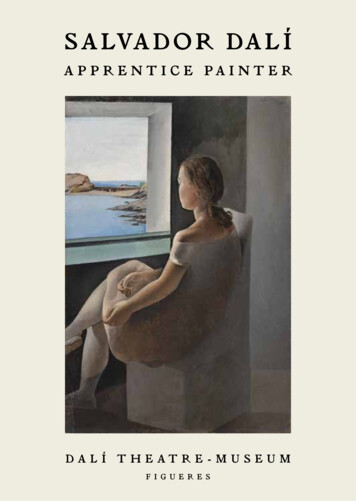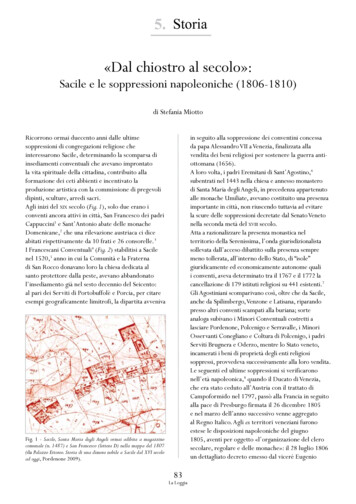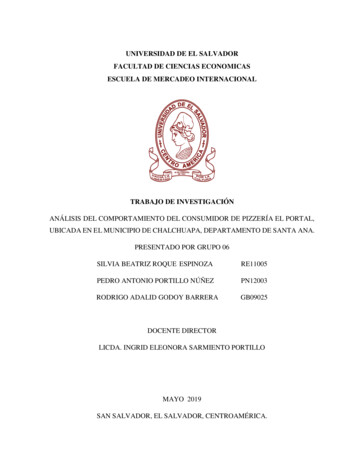
Transcription
S a lva d o r Da l íA p p r e n t i c e pa i n t e rDALÍ T H EATRE - M U S E U MF I G U ERE S
Interpretation of Figure in Profile«Les belles formes, ce sont desplans droits avec des rondeurs. Lesbelles formes sont celles qui ont dela fermeté et de la plénitude, et oùles détails ne compromettent pasl’aspect des grandes masses.»11. “Beautiful shapes are straight planes withcurves. Beautiful shapes have both firmnessand fullness and in them the details do notcompromise the appearance of large masses.”Jean-Auguste-Dominique Ingres, Pensées,Editions de la Sirène, Paris, 1922, p. 76.In January 1922, the year in which Dalí joined theReal Academia de Bellas Artes de San Fernando inMadrid, Galeries Dalmau in Barcelona2 organised awidely publicised group exhibition by the Association ofCatalan Students. At this exhibition, for the first time,the young Dalí exhibited eight works, one of which,Market,3 received the university chancellor’s award.It was not until 14 November 1925, however, thatthe artist, who was only twenty-one years old,held a solo exhibition of paintings and drawingsat Galeries Dalmau. These works combined twoaspects that would alternate and complement oneanother throughout his career and that arose fromhis bold and critical analytical approach towardsall types of conventionality: a return to order andtradition, and a search for the most avant-gardetrends. Ninety-two years have passed since his workswere first shown at Galeries Dalmau, until the timevisitors to the Dalí Theatre-Museum in Figueresagain have had the chance to view one of the oilsfrom the original exhibition —the least known ofthem all— entitled figure in profile . 4The press of the time covered the exhibition by thisapprentice painter5 in great depth. All observed inSalvador Dalí the simultaneous presence of the strongcubist influence of the avant-gardes and a style thatreferenced tradition and, specifically, Ingres. We arevery much aware that Dalí kept both the pictorial andwritten work of the latter firmly in mind —particularlythe book Pensées—. Three quotes that the painterincluded in the exhibition catalogue are in fact takenfrom this book in which Ingres reflects on painting2. The organiser,the art dealer JosepDalmau, introducedthe avant-gardemovements inCatalonia andpromoted the mostinteresting Catalanartists of the time.He was, as Dalídescribed years laterin his autobiographyThe Secret life ofSalvador Dalí,the “Barcelonianpatriarch of theadvance-guardismand who looked asthough he mighthave just steppedout of a paintingby El Greco.”3. Market, c. 1921,location unknown,cat. no. 359.4. Figure in Profile,1925, FundacióGala-Salvador Dalí,Figueres, cat.no. 147.5. As his father,Salvador Dalí Cusí,described himin the notebookwhere he kept presscuttings and wrotecomments abouthis son’s exhibitionsand journey towardsbecoming anestablished artist.
6. Salvador Dalí,André Parinaud,The Unspeakableconfessions ofSalvador Dalí,William Morrow,New York, 1976,p. 56.and expresses some artistic concepts that Dalí wasworking with at that time. Throughout the exhibitionwe can therefore clearly observe the influence of theworks promoted by the magazine Valori Plastici andof which Dalí was a great admirer.Dalí himself later referred to this initial period of constantexperimentation, so evident in the Dalmau exhibition:“I at the time was painting Cadaqués landscapes, myfather, my sister, everything that could be a subjectfor my frenzied brush. I was paying close attentionto Chirico’s paintings, through the magazines. I wascontributing to Barcelona’s Gaseta de les Arts and L’Amicde les arts; and one book was always at my bedside,Ingres’ Thoughts. I decided I would take some essentialnotes out of it as preface to my first one-man show, atthe Dalmau Galleries, Barcelona, in November 1925.[ ] This tribute to the beauties of craft and traditioncorresponded exactly to my own ideas. This is thebasis on which one can afford to be a genius. [ ]The critics, who are always laggards and unaware oftruth, were nevertheless enthusiastic.”6Landscape of Cadaqués, c. 1921The exhibitioncatalogue at theGaleries Dalmau, 1925Seated Girl, 1925In this first solo exhibition, Dalí presented seventeenoils and five drawings. Six of the paintings exhibitedwere portraits of his sister Anna Maria, almost alwayswith her back to the viewer: Seated Girl, Figure Seenfrom the Back, Girl at a Window, figure in profile ,Portrait of My Sister and a sixth oil painting withthe same title. He also presented other portraits—such as Portrait of My Father, Portrait of RamonetaMontsalvatge and Portrait of Maria Carbona, the lattertwo friends of the Dalí family—, accompanied byworks chiefly featuring the landscape, specificallyLandscape of Cadaqués and Empordà Landscape withFigures, as well as the works Figure at a table andVenus and Sailor (Homage to Salvat-Papasseit). Incubist style the artist exhibited Pierrot Playing theGuitar (Cubist Painting), Siphon with Small Bottle ofRum (Cubist Painting) and Still Life (unidentified).The exhibition catalogue closes with another StillLife that we have also been unable to identify.77. The worksmentioned can beviewed online in theCatalogue Raisonnéof Paintings bySalvador Dalí: http://www.salvador-dali.org/cataleg raonat/index.php .
8. Anna Maria Dalí,Salvador Dalí vistopor su hermana,Juventud, Barcelona,1949, pp. 105and 111.figure in profile was acquired for 500 pesetasby the pharmacist and family friend Joaquim Cusíi Furtunet. It was not exhibited again until it wasauctioned at Bonhams in London on 2 March 2017,when the Fundació Gala-Salvador Dalí purchased it.The only record of the painting hitherto encounteredis a black and white reproduction published inthe magazine Atlántico in 1929.Anna Maria’s words come to life in this work, in which she is portrayedwith calm and corporeal realism in the centre of the scene andfocal point for the artistic composition. The simplicity of design andapproach to the room’s empty spaces evoke a peaceful atmosphere.The three-quarter view of the girl’s profile and the direction of hergaze yield gentle movement and guide the viewer’s full attentiontowards the top left quadrant of the work, where the landscape ofCadaqués is visible through the window. The landscape can clearlybe identified as Es Sortell, an area near the home of the Pichots,a family of artists to whom the Dalís were very close. It shows thecharacteristic bridge connecting it to the adjacent island, whichDalí could see from the window of his studio at his father’s homein Es Llaner. The landscape through the window is calm, shapedwith geometric precision and the result of detailed, metaphysicalobservation.Portrait of My Sister, 1925The central figure in the painting is the artist’ssister, Anna Maria, his main model until Galaarrived in 1929. Anna Maria wrote about themoments of close rapport with her brother: “Mybrother painted countless portraits of me duringthat period. Many of them were mere studies ofcurls and of a shoulder always uncovered. Hepainted patiently, tirelessly, and posing for himdid not tire me at all, as I have never been boredby staying still and silent.” She continued: “Duringthe hours that I modelled for him, I never tired oflooking at that landscape which has forever beena part of my life. He always painted me close toa window [.].”8Figure at a table, 1925This clear, infinite space of sea and rocks visible outside the windowwas painted with a bright, diffused light that gently illuminates thefigure of the girl, leaving her back and delicate curls over her bare
shoulder in the shadows. It appears to be a winter’s day in whichtime has been diluted by the landscape’s serenity and in the calmemanating from the figure, whose face, neck, shoulder, arm andhands, legs and lap are all delicately illuminated. The composition, inwhich empty space plays a key part, is meanwhile elegantly balancedby the pale grey light that enters vertically from the right to yielda silence that envelops the figure. The Italian metaphysical style ofpainting is fully apparent in the robustness of the elements, theirseparation in space, the secret dialogue established among them,the play and convergence of the perspectives, the geometric form ofthe shapes and the light created by the warm tones reminiscent ofGiorgio Morandi.Portrait of Maria Carbona, 1925Girl at a Window, 1925As in many of the portraits of his sister from the same period, the figureis portrayed with her back slightly turned to the viewer, revealing herface in profile. Seated, with her legs crossed and hands resting in herlap, she reclines in a chair with a distinctly cubist feel to it. Here, thelight is not frontal but instead originates from the background, fromthe window and from the top of the canvas.Venus and Sailor (Homage to Salvat-Papasseit), 1925
The softness of colour intensifies in the zone emphasised by thickerbrushstrokes that texture the landscape with sky blues, whites andochres; in the white and bluish greens of the window frame, and inthe flesh and pink tones of the figure and her dress. In contrast, theroom’s shadows are painted predominantly in dark colours, greysand browns applied with a thin, diluted pictorial layer that is almosttransparent in the area of the buttocks.Portrait of My Father, 1925figure in profile ,a portrait and representation that transcendsthe strictly real, distils the wisdom of the masters and a vehementdesire to experiment. The painting reveals a purposeful distance fromthe enthusiastically colourful palette of impressionism and, rather,resembles the approaches of cubism and the magazine Valori Plastici,all framed in the essential, eternal and future iconic landscape ofCadaqués. This portrait points to the future Salvador Dalí and likethe other four oil paintings owned by the Fundació Gala-SalvadorDalí that accompany and complement it in this exhibition, exemplifiesSalvador Dalí’s learning period with absolute clarity.Pierrot Playing the Guitar (Cubist Painting), 1925
S a lva d o r Da l ía p p r e n t i c e pa i n t e rd a l í t h e a t r e - mus e umf i gu e r e snovember 2017 - december 2018#AnnaMariaDalíc o v e ri m a g eSalvador Dalí, Figure in Profile, 1925e x h i b i t i o ncurator:Montse Aguer, director of the Dalí Museumscoordination and assistance: Cuca R. Costa (Centre for Dalinian Studies)design: Pep Canaleta — graphics: Alex Gifreupreventive conservation: Irene Civil, Josep M. Guillamet and Elisenda Aragonèsregistrar: Rosa Aguer — communication: Imma Parada — web and social media: Cinzia Azzinic a t a l o gu eedition:Fundació Gala-Salvador Dalí — coordination: Nuri Aldeguer (Educational Service)text: Montse Aguer, with the collaboration of Irene Civildocumentation: Centre for Dalinian Studies — design: Alex Gifreutranslations: Link Traduccions i Serveis Salvador Dalí, Fundació Gala-Salvador Dalí, Figueres, VEGAP, 2017
Salvador dalí apprentice painter dalí tHeatre-MUSeUM FiGUereS noveMber 2017 - deceMber 2018 #annaMariadalí cover iMaGe Salvador Dalí, Figure in Profile, 1925 exHibition curator: Montse Aguer, director of the Dalí Museums coordination and assistance: Cuca R. Costa (Centre for Dalinian Studies) design: Pep Canaleta — graphics: Alex Gifreu preventive conservation: Irene Civil, Josep M .











